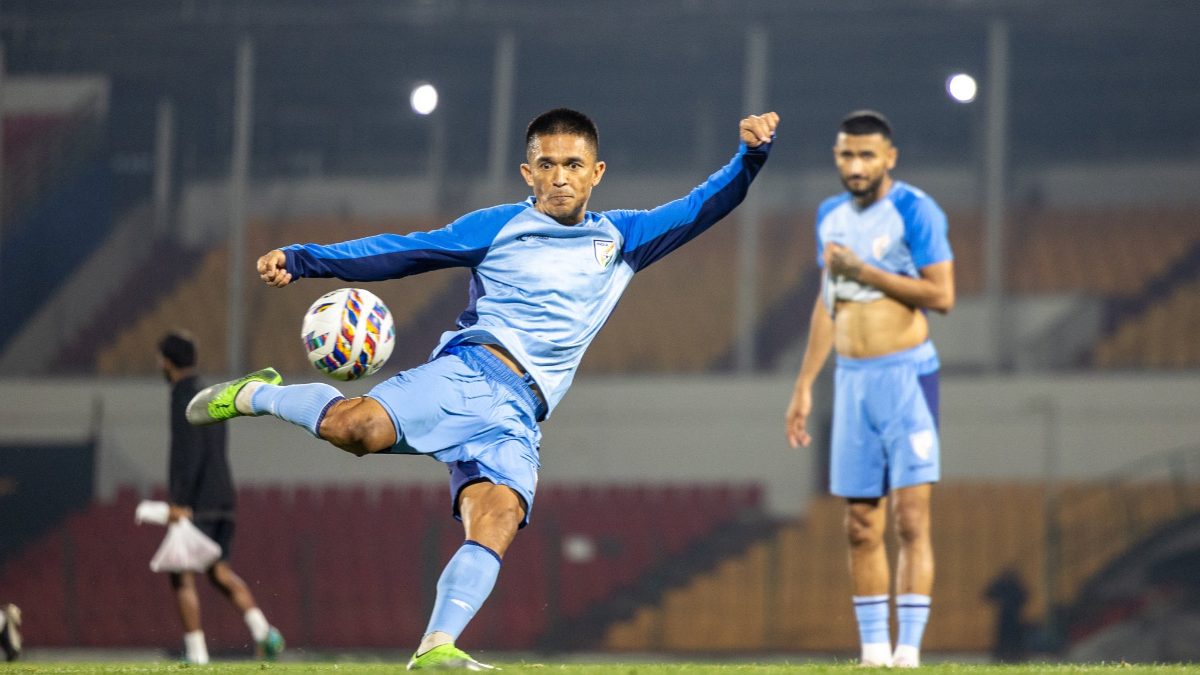Scrolling down just a bit on Sunil Chhetri’s timeline on X, a beautiful tweet appears — one that perfectly encapsulates the legendary striker’s career with the Indian football team. The final sentence of that tweet reads: “Maa tujhe salaam” (Salute to you, mother).
Sports careers are built on skill, technique, development and glory, but when representing the national team, duty, passion and motivation take precedence. Personal milestones fade into the background — there’s only one goal: to win for the nation. Money holds little significance; true glory is measured only in trophies.
Playing for the Indian football team, with little financial incentive and limited success on the pitch, is an even greater challenge. But this never mattered to Chhetri, because for him, "nothing comes close to playing for the country."
प्यार है बस तेरा, प्यार ही
— Sunil Chhetri (@chetrisunil11) July 5, 2023
माँ तुझे सलाम। 🤍 pic.twitter.com/Yog9j5pMAA
So, he’s back! At 40, reversing his international retirement , which he announced last year after bringing an end to his illustrious India career with a heart-breaking draw against Kuwait at the Salt Lake Stadium in Kolkata.
But let me add it here. He isn’t back because he missed the blue jersey beyond what he could resist. Chhetri, the owner of 94 international goals in 151 matches, is back because the Indian football team needs him now more than ever.
India need Chhetri’s goals now more than ever
Having made history by leading India to two back-to-back AFC Asian Cup appearances in 2019 and 2023, Chhetri and Blue Tigers now stand on the cusp of history — qualifying for a third consecutive time for the first time ever.
India are drawn in Group C alongside Bangladesh, Hong Kong and Singapore in the final round of qualifiers and only one team, the winner of the group will advance to the Asian Cup proper.
Despite the Asian Cup expanding to 24 teams since the 2019 edition, the Blue Tigers are on thin ice, with their performances declining with each passing game — a reality reflected in their abysmal 126th FIFA ranking.
Igor Stimac made way from Manolo Marquez last season after India unsurprisingly missed the bus for the 2026 World Cup but results have been far from positive: One defeat, three draws and only two goals scored.
You can’t hold it against Marquez, who has had very little time with the national team to drill down his philosophy and has a woefully limited talent pool to work with. Hence, the need for the talismanic Chhetri.
Explaining Chhetri’s return in the press release announcing the squad, Marquez had said, “The qualification for the Asian Cup is very crucial for us. Given the importance of the tournament and the matches ahead, I discussed with Sunil Chhetri about making a comeback to strengthen the National Team. He agreed, and so we have included him in the squad.”
The return of ‘SC11’ may feel like a return to normalcy for Indian football fans, but in reality, it exposes the harsh truth about our game — that, with all due respect to our former captain, we are once again forced to rely on a 40-year-old to carry us across the line.
That thought dampens any enthusiasm Chhetri’s return might have sparked.
In his fifth decade on earth, Chhetri is the second-highest goal-scorer in the ongoing season of the Indian Super League (ISL), and is the highest among Indians with 12 goals. The next best is seven goals from Brison Fernandes, who is 17 years younger than Chhetri and not even a striker.
Here lies the main explanation behind his return. India don’t have strikers who can score goals. Forget internationals. India don’t have strikers scoring goals in the local league as well.
The recent press release denoted Farukh Choudhary, Irfan Yadwad, Lallianzuala Chhangte and Manvir Singh as forwards but except for Yadwad at times for Chennaiyin FC, none of them play as strikers at their respective clubs.
The situation is not much different in the second-division I-League which is equally reliant on foreign strikers and Indian forwards are still only making up the numbers.
If the best football clubs don’t field Indian players as strikers, it’s difficult to imagine how forwards for the national team will emerge.
Chhetri’s comeback has a message for Indian clubs
One may argue that the prime objective of the clubs is to win trophies, especially in the Indian ecosystem where the medium of revenue generation is finite and restricted. And you won’t be wrong in making this argument.
In an ideal scenario, even with clubs preferring overseas strikers, a vast number of clubs, divisions, a well-structured age-group system and a robust grassroots programme would have produced enough strikers. But the reality of Indian football is that it’s grossly imperfect — it’s broken, held together by the ISL, which has survived despite massive financial losses.
But things must change because Chhetri will soon be 41, then 42 and so on. While medical science has made significant advancements, he cannot remain the answer to the ‘Who after Chhetri?’ question forever.
So, what’s the quick fix? Follow Chhetri.
Just as the 40-year-old legend has once again put the country ahead of himself, clubs, too, can make a big impact by regularly fielding at least one Indian striker, as much as possible.
It won’t be easy. Some may hesitate if others don’t take the lead, but together, perhaps we can bring about the change that the flawed Indian football ecosystem has struggled to achieve.


)
)
)
)
)
)
)
)
)



